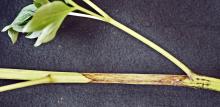Cause The fungus Sclerotinia sclerotiorum causes stem rot in many plants and occasionally attacks peony. Overwintering sclerotia can survive many years in soil. The disease develops in cool, wet conditions and is more prevalent when plants form a complete, compact canopy that holds high relative humidity. The fungus can colonize dead organic plant matter and survive many years. Plants can be infected when host tissue colonized by the fungus comes in contact with healthy tissues. Plants can also be infected by mycelia growing on the soil surface. In the potato system, flowers are very susceptible to infection and are the main source of stem infection. Infected petals fall onto stems allowing the fungus to gain entry into the stems. Direct penetration, of stems in contact with the soil, from germinating soilborne sclerotia also occurs.
Symptoms Shoots suddenly wilt and fall over. The fungus can be seen growing at the plant crown as a fluffy white mycelium. Large black sclerotia form in the stem's pith region and on the surface of infected tissues. Lesions on the foliage and flowers can also occur, which turn brown and also become covered with a fluffy white mycelial growth under moist conditions.
Cultural control
- Remove and destroy diseased plant parts both during the season especially spent flowers.
- Remove and destroy whole plants that have this disease. Replant the site with less susceptible plants.
- Removing the top few layers of soil around plants may reduce risk by removing sclerotia.
- Space plants for good air circulation.
- Avoid overhead irrigation or any practice that keeps plants wet for extended periods of time.
Chemical control Some fungicides applied to flowers have worked well in vegetable systems where the epidemiology is better understood. The following materials may provide protection; however, few ornamental trials have been done to demonstrate the best timing.
- Thiophanate-methyl-based products. Tank-mix with another product. Group 1 fungicide. 12-hr reentry.
- Bonide Infuse Systemic Disease Control Lawn and Landscape at 3 lb/1,000 sq ft. Activate with 0.1 to 0.25 inches water within 24 hr after application. H
- Cleary's 3336 EG at 12 to 16 oz/100 gal water.
- According to one IR-4 trial Pageant was safe on peony but had elevated residues. It may be useful for this disease at 6 to 12 oz/100 gal water. Do not use with organosilicone-based adjuvants. Group 7 + 11 fungicide. 12-hr reentry.
Biological control
- Contans WG (Coniothyrium minitans strain CON/M/91-08) at 1 to 4 lb/A. Spray soil surface and then incorporate 1 to 2 inches with water or disc. Less effective in soils over 85°F and under 35°F. 4-hr reentry. O
Reference Garfinkel, A.R., and Chastagner, G.A. 2018. Diseases of Peonies. In McGovern, R.J. and Elmer, W.H. (eds.) Handbook of Florists' Crops Diseases. Springer Int.


